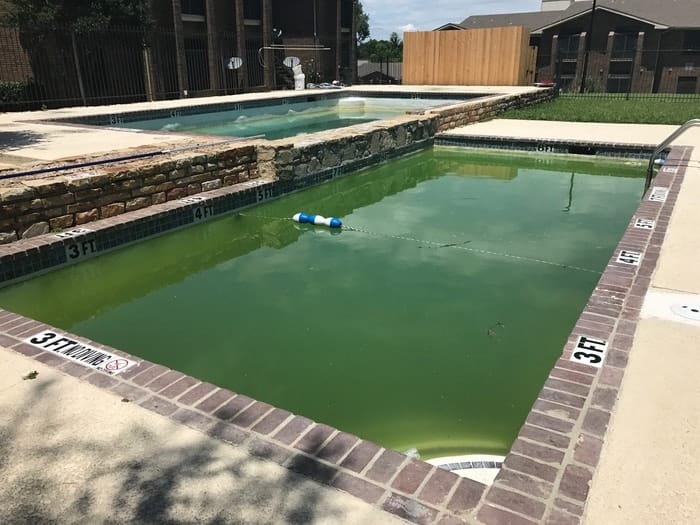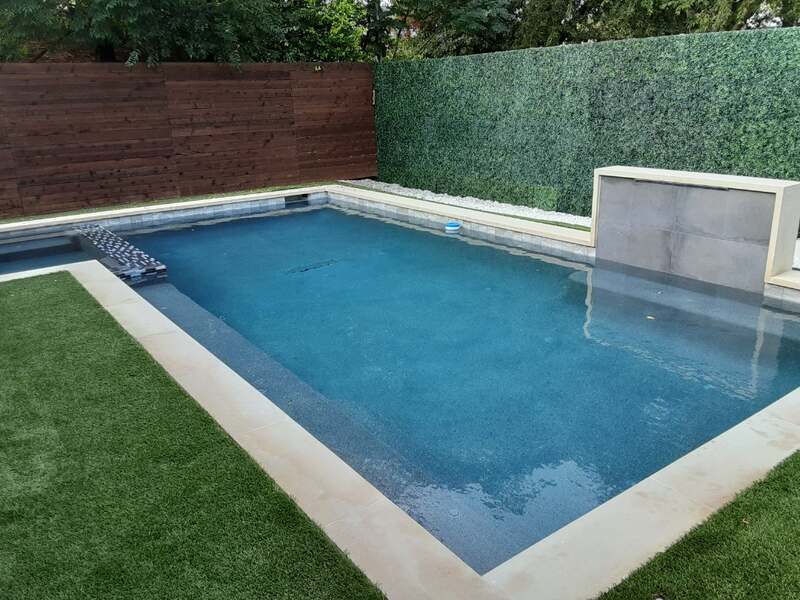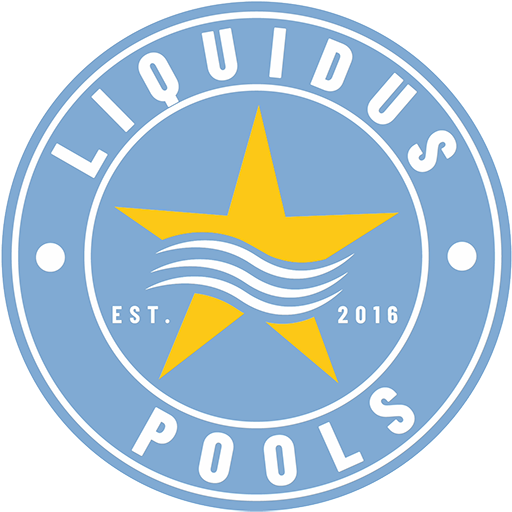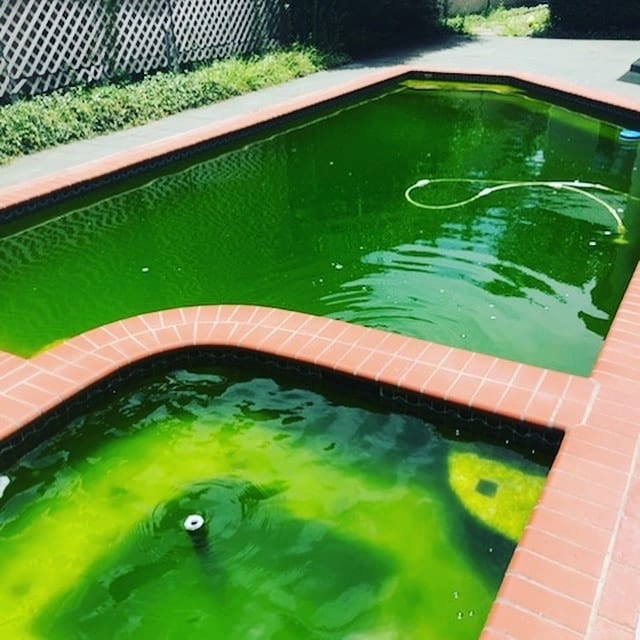Table of contents
Types of Swimming Pool Algae and Treatments
Swimming in a pool can be an incredibly rewarding experience. But nothing takes you out of the moment faster than being surrounded by pool algae. In this blog post, Liquidus Pool Services will be taking a look at some of the different types of pool algae, what causes them, and how they can be treated.
There are a number of ways you can remove the algae from your pool. However, it is best to have a professional clear the algae from your pool. At Liquidus Pool Services, we have the knowledge and skill to return your pool to a clean state. You can save yourself the uncertainty of trying to battle against algae yourself and get the peace of mind that working with a professional brings.
Given the potential risks involved with algae, people and animals should not use the pool until it has been properly cleaned and is algae free.
Liquidus Pool Services Tips:
- Please wear chemical-resistant gloves and eye protection when handling any pool chemicals.
- After applying a pool shock product to your pool, be sure not to go swimming until the chlorine levels have returned to normal.
Pool Algae

Algae are living organisms that are part of the plant kingdom. They can form on pool walls, floors, and steps, and even float on the surface of water. Given the abundance of water in a swimming pool, it is a prime location for algae growth.
Pool algae can contain many hazards, such as parasites, E. coli, and salmonella — all things you do not want to swim with.
Different types of algae look different and have different causes.
Black Algae
Black algae are technically not algae but single-celled organisms, though people call it black algae because it behaves like algae. It requires a shock treatment to get rid of the infestation.
As with real algae, black algae can carry E. coli and other harmful bacteria. Black algae do not require sunlight and can make their own food. As a result, they can grow quickly and aggressively.
Black algae naturally dig into the pool’s walls and floors with their roots. Colonies also have a protective layer, making them harder to kill than other types of algae. You may need a thorough scrubbing or power washing to remove black algae completely. Even after effectively scrubbing black algae away, you must apply an aggressive shock treatment to completely rid your pool of any remaining particles.
Black Algae Causes
This rather aggressive single-celled organism is only found in coastal areas, which makes it exceedingly rare in the Dallas-Fort Worth area.
For black algae to get into your pool, it would have to be because you were at the beach very recently and did not wash your bathing suit before getting into your household pool.
Black Algae Treatment
- Step One: Using a pool test kit, check to see if your pool chemicals and pH levels are balanced.
- Step Two: Boost the resident chlorine by using a pool shock. Be sure to read the instructions for the pool shock carefully.
- Step Three: If you have a plaster pool, scrub the black algae’s protective layer with a pumice stone. If you don’t have a plaster pool, use a stiff-bristled brush.
- Step Four: Take a pool brush and vigorously scrub the areas with black algae.
- Step Five: Vacuum up the algae.
- Step Six: Allow the water to circulate for 24 hours.
- Step Seven: Get rid of any dead algae by using a pool vacuum or by backwashing your pool. If the black algae are persistent, repeat the third through seventh steps every two to four days.
Brown Algae
Brown algae is a multicellular algae, with the majority of its species living in salt water. Brown algae generally stick to surfaces.
While brown algae are rarely harmful, they can lead to illness.
Certain species of brown algae have a bladder filled with a gas that may be hazardous to your health. These species of brown algae use the bladder to float and to make sure their blades stay close to the surface of the water.
Brown Algae Causes
Brown algae can appear in pools without a proper chemical balance. They can also grow in shady areas, especially in hot temperatures. They can also grow in cool water.
Brown Algae Treatment
To get rid of brown algae completely, you may need to do several treatments.
- Step One: Make sure that your pool’s pH level is somewhere between 7.2 and 7.6.
- Step Two: Clean the pool as well as you can. Use a brush, leaf rake, and vacuum to break up the brown algae.
- Step Three: Run your pool filter and backwash it to move more debris.
- Step Four: Use chlorine to shock your pool. Next, add an algaecide that is made for swimming pools. Be sure the algaecide does not contain copper.
- Step Five: Wait overnight for the algaecide to do its job. Then vacuum the pool and backwash the filter again.
- Step Six: Repeat this process each day until the pool is cleaned and the water is clear.
- Step Seven: Once the algae are out of the pool, thoroughly clean your pool filter.
Green Algae
Green algae, also known as blue-green algae or Chlorophyta, is a slimy substance that can grow on any pool or spa surface. Green algae usually start in small clusters on pool steps or in the corners of the pool. While it may seem like a fairly innocent form of algae, it only takes twenty-four hours to spread.
As algae continue to grow, you may find patches floating on the water’s surface. This, in turn, gives your pool a greenish tint. This is the most common type of algae found in North Texas swimming pools.
Green algae has several health risks associated with it. Some green algae are capable of producing harmful toxins. Exposure to green algae is hazardous to the health of people and animals.
Green Algae Causes
Green algae grow best in lakes and ponds. The particles from green algae can get stuck on bathing suits from swimmers who have recently swam in a lake. Green algae also have an opportunity to grow when pools have poor filtration or if the water has been left unbalanced.
Green Algae Treatment
- Step One: Test your pool with a water tester kit to determine the stabilizer, chlorine, and pH levels.
- Step Two: Use a pool shock product to increase your pool’s residual chlorine. Be sure to follow the instructions for the pool shock.
- Step Three: Take a pool brush and vigorously scrub pool surfaces covered in algae, such as floors, walls, and steps.
- Step Four: Allow the pool water to circulate for 24 hours. Then, brush the surfaces of the pool once more.
- Step Five: Get rid of any remaining dead green algae by using a pool vacuum or backwashing your pool.
Yellow Algae (Mustard Algae)
Yellow algae, also known as mustard algae, has a distinctly pollen-like appearance. Yellow algae is actually a form of green algae. It collects in shady areas of your pool because it does not grow well in direct sunlight, preferring shaded places. This type of algae is chlorine resistant and requires an aggressive shock treatment to be completely removed from the pool.
As with other types of algae, yellow algae can contain harmful bacteria, including E. coli.
Yellow Algae Causes
Yellow algae are very uncommon in the Dallas-Fort Worth area. For your home or pool to be infected with yellow algae, your home needs to be located near a river that has an ongoing population of yellow algae. Furthermore, yellow algae do not stick to clothing very well, but it can arrive in your pool via a strong breeze.
Yellow Algae Treatment
Treating yellow algae is difficult, as it can stick to anything in your pool.
Follow these steps to remove yellow algae from your swimming pool:
- Step One: Using a pool testing kit, test and balance the chemical levels in your pool.
- Step Two: If needed, increase residual chlorine levels by adding a pool shock product to your pool. Be sure to follow the instructions for the pool shock carefully.
- Step Three: Take a pool brush and vigorously scrub the surfaces in the pool that have algae.
- Step Four: Using either a pool vacuum or backwashing, clean out the dead algae in your pool.
- Step Five: Use a yellow/mustard algaecide on the pool. Be sure to follow the instructions.
- Step Six: Let the pool water circulate for 24 hours.
- Step Seven: Remove any remaining dead algae by either using a pool vacuum or by backwashing your pool. If the yellow algae persist, brush the pool again and apply algaecide after two to four days.
Liquidus Pool Services Tip:
Because of yellow algae’s ability to stick to things, it is vital that everything that has gone into the pool, such as bathing suits and toys, gets thoroughly washed.
Pink Algae
Pink algae are also known by another, less formal name, “pink slime.” Pink slime is particularly aggressive because it can grow quite well inside PVC pipes. Pink algae are also not algae but a form of bacteria with algae-like characteristics.
While not hazardous to human health, pink algae can be harmful to your pool. This is because pink algae can clog up the filtration pipes and cause them to burst from too much pressure.
Pink algae can also cause surfaces to become slick, leading to potentially dangerous situations around a pool, such as slipping and falling.
Pink Algae Causes
Pink algae form when the water pH levels are unbalanced. Pink algae may flourish in the dark areas of your pool where there is a slow current. That’s why if you have PVC plumbing, you need to be on the lookout for pink algae. An aggressive chlorine treatment will be able to eliminate any pink algae growth in your pool or pool plumbing.
Pink Algae Treatment
- Step One: Get the pink algae out of the pool filter. If your pool has a D.E. or sand filter, you’ll need to backwash it. If your pool uses a cartridge filter, it will need to be cleaned off or replaced.
- Step Two: Test your pool’s water.
- Step Three: Ensure that your pool water is balanced.
- Step Four: Shut off your pool’s pump.
- Step Five: Brush your pool.
- Step Six: Apply an anti-pink algae product.
- Step Seven: Apply a shock product to your pool. Use roughly three to four pounds of shock for every 10,000 gallons of water in your pool. Be sure to give your pool time to return to normal chlorine levels before entering it.
- Step Seven: Brush your pool again.
- Step Eight: Vacuum out your pool.
- Step Nine: Reclean or replace your filters. When recleaning your filters use a chemical cleaner that is specific to your type of filter.
- Step Ten: Turn your pool’s pump back on.
Ways to Prevent Pool Algae

While pool algae come in many types, some common steps you can take to reduce the likelihood of it developing in your pool include:
- Consistently clean your pool’s pump, filter, and skimmer.
- Regularly monitor your pool’s water balance.
- Utilize regular algaecide pool treatments.
- Ensure that your pool’s filtration system is working properly.
- Shock your pool each week. Be sure to do this before applying algaecide to your pool, as neither will work if used at the same time.
- Brush the steps, floors, and walls of your pool frequently.
- Regularly vacuum out your pool.
Pool Algae Treatment in Dallas, Texas

When it comes to removing algae from your pool and keeping your pool algae-free in the Dallas Fort Worth Metroplex, you can depend on the professionals at Liquidus Pool Services. Our team members are licensed and certified, so you know you are dealing with professionals. Since 2017, we’ve been helping pool owners get the most out of their pools. In addition to treating pool algae, our award-winning company also offers pool cleaning, pool maintenance, pool repair, pool renovations, and pool installation.
We look forward to making your pool a welcoming and enjoyable place to spend warm days. Contact us to receive a free quote!

